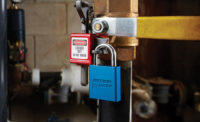Protecting workers from hazardous energy through Lockout/Tagout (LOTO) is a basic safety responsibility, but there are additional steps employers can take that go beyond the basic requirements. OSHA scrutiny and fines have increased in 2023, and yet employers can precisely follow OSHA standards for “The Control of Hazardous Energy (Lockout/Tagout)” and still face some scenarios that guidelines can’t cover.
Beyond OSHA, since LOTO is a protocol that prevents machinery from unexpectedly turning on during installation, cleaning, or maintenance, increasing the level of safety is paramount to preventing electrocution, severe injury, or even permanent disability. These steps can help workplaces go from basic LOTO protocols to comprehensive safety measures.
Comprehensive Approach: Comprehensive safety begins with a comprehensive approach. Hazardous energy management covers six key areas: scope, purpose of each step, required practices, authorized personnel, safety methods, and devices. All six areas are critical to ensuring employee safety. In other words, even though lockout devices restrain machines from starting up and tagout tags alert workers that a machine is out of service, the equipment alone is not enough to ensure a safe workplace. Written procedures need to be in place and aligned with the right equipment.
Training: Training is critical to ensure that written procedures are communicated to all employees, even those not directly handling equipment, and carefully followed every time. While LOTO training generally takes place when an employee is onboarded, there is a procedural change to a machine, or there is a personnel change, annual or even semi-annual reminders can increase workplace safety. Even though annual trainings and policy reviews are not mandated by law, and training doesn’t officially expire, incorporating a workplace refresher into training practices helps reinforce the information in employees’ minds and prevent confusion in a LOTO situation.
Roles/Responsibilities: Written guidelines need to be very detailed about LOTO roles and responsibilities, so it’s always clear who is doing what. Are specific people in charge, or only people in a specific position? Since many of these decisions are left to the discretion of the employer, roles can vary from place to place. For example, a small manufacturer may allow any employee who is properly trained to take on LOTO responsibilities, while a large plant may designate that only managers at a certain level can be in charge of LOTO. Regardless of who is managing lockout devices and tagout systems, all employees in the vicinity of the equipment should be trained on the procedures.
Contingencies: Even the most detailed safety procedures need contingencies for unexpected events or situations. For example, it’s standard practice that the person who puts a lockout device on needs to be the one to take it off. But what if this person has called in sick, left for the day, or is otherwise unavailable? Does the employer contact the employee and ask them to come in off shift, or are there protocols in place that allow a supervisor to act as a proxy to remove the device? These are the types of questions that aren’t covered in basic OSHA guidelines, but an employer could easily face. Having a written, agreed-upon standard for lockout device coverage in someone’s absence can ensure the workplace can continue operations while keeping employees safe.
Review: With these five basic steps, a workplace will have a foundation of safety to protect employees.
From there, instituting a regular LOTO review prevents information from becoming outdated and certifies that all employees are fully aware of the LOTO procedure. A buying guide can also help a company review its LOTO procedure to make sure all areas of safety are covered.
- Develop comprehensive, written lockout/tagout guidelines. Detail the specific steps for each type of equipment and LOTO procedure.
- Locate and label all energy isolation points with permanent tags.
- Train all authorized personnel to carry out safety procedures, and train any and all employees who may be working near hazardous machinery to understand the procedures.
- Utilize secure lockout/tagout devices.
- Perform regular reviews of the LOTO procedures and make adjustments as necessary to maintain optimal safety.
Taking a LOTO procedure from basic to comprehensive does more than satisfy OSHA requirements. It enhances a culture of ongoing safety, protects your business from a disruption or a tragic event, and maintains the health and workplace happiness of your employees.






